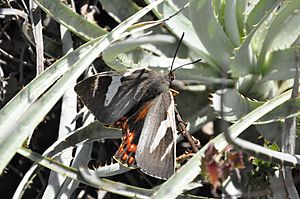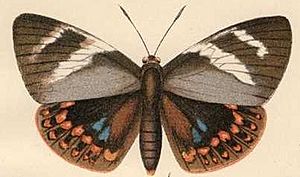Castnia eudesmia facts for kids
Quick facts for kids Castnia eudesmia |
|
|---|---|
 |
|
 |
|
| Scientific classification | |
| Kingdom: | |
| Phylum: | |
| Class: | |
| Order: | |
| Family: |
Castniidae
|
| Genus: |
Castnia
|
| Species: |
C. eudesmia
|
| Binomial name | |
| Castnia eudesmia Gray, 1838
|
|
| Synonyms | |
|
|
The Castnia eudesmia is a special type of moth. It belongs to a group of moths called the Castniidae family. This moth is found only in Chile, a country in South America. It was first described by a scientist named Gray in 1838.
Contents
Discovering the Castnia Eudesmia Moth
The Castnia eudesmia is known for its unique look. Moths are insects that are often confused with butterflies. However, moths are usually active at night, while butterflies fly during the day. This particular moth is part of a family that sometimes acts more like butterflies.
What Makes Moths Special?
Moths are fascinating creatures. They start their lives as tiny eggs. These eggs hatch into larvae, which are also known as caterpillars. Caterpillars spend their time eating and growing. They shed their skin several times as they get bigger.
After growing enough, the caterpillar forms a pupa. For moths, this pupa is often called a cocoon. Inside the cocoon, the caterpillar undergoes an amazing change. This process is called metamorphosis.
Finally, a beautiful adult moth emerges from the cocoon. The adult moth has wings and can fly. Its main job is to find a mate and lay eggs, starting the life cycle all over again.
Where Does the Castnia Eudesmia Live?
The Castnia eudesmia moth makes its home in Chile. Chile is a country with many different types of environments. It has mountains, deserts, and coastal areas. This moth is considered an endemic animal. This means it is found naturally only in Chile and nowhere else in the world.
Being endemic makes the Castnia eudesmia very important. It is a unique part of Chile's natural heritage. Scientists study these moths to understand their role in the local ecosystem. They also learn how to protect them and their habitat.
See also
- Mariposa del chagual para niños (Information in Spanish for kids)

